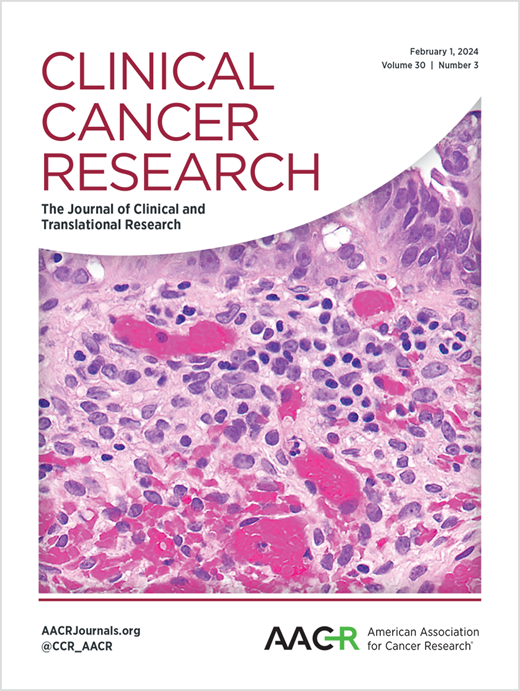Supplementation of Tamoxifen with low-dose Endoxifen in breast cancer patients with impaired tamoxifen metabolism (TAMENDOX): a randomized controlled phase 1/2 trial
IF 10.2
1区 医学
Q1 ONCOLOGY
引用次数: 0
Abstract
Purpose: Tamoxifen undergoes bioactivation to its active metabolite (Z)-endoxifen, which blocks estrogen-dependent breast tumor growth at high potency. We tested the feasibility and safety of supplementing standard tamoxifen therapy with low-dose (Z)-endoxifen in breast cancer patients with compromised tamoxifen bioactivation. Patients and Methods: We conducted a prospective, interventional, three group randomized trial including 235 hormone receptor-positive breast cancer patients who received standard tamoxifen therapy (20mg/day). Patients were stratified by CYP2D6 genotype (n=78), defining poor (PM), intermediate (IM) and normal metabolizers (NM), or by baseline (Z)-endoxifen plasma concentration (n=78), defining ≤15 nM, 15-25 nM and ≥25 nM. Co-treatment with (Z)-endoxifen 3, 1.5 mg/day or placebo was performed, respectively. A control group (n=79) received placebo regardless of metabolizer phenotype. The primary endpoint was the number of patients with (Z)-endoxifen levels >32 nM after six weeks treatment. Adverse events were continuously monitored. Results: A higher proportion of patients in both intervention groups achieved target concentrations >32 nM compared to control (P < 0.0001). At 3 mg (Z)-endoxifen supplementation, 92.3% of CYP2D6 PM patients and all patients with baseline (Z)-endoxifen ≤15 nM achieved the target concentration. At 1.5 mg (Z)-endoxifen supplementation, 88% of CYP2D6 IM patients and 95% of patients with 15-25 nM baseline (Z)-endoxifen levels achieved the target concentration. Similar proportions of patients receiving (Z)-endoxifen (6/80, 7.5%) or placebo (8/155, 5.2%) experienced Grade 3 adverse events. Conclusion: Adding low-dose (Z)-endoxifen to standard tamoxifen is safe and provides a new approach to personalized anti-estrogen treatment for patients with low endoxifen plasma levels.他莫昔芬与低剂量内氧昔芬在他莫昔芬代谢受损乳腺癌患者中的补充:一项随机对照1/2期试验
目的:他莫昔芬对其活性代谢物(Z)-endoxifen具有生物活性,可高效阻断雌激素依赖性乳腺肿瘤的生长。我们测试了在他莫昔芬生物活性低下的乳腺癌患者中,用低剂量(Z)-endoxifen补充标准他莫昔芬治疗的可行性和安全性。患者和方法:我们进行了一项前瞻性、介入性、三组随机试验,包括235名接受标准他莫昔芬治疗(20mg/天)的激素受体阳性乳腺癌患者。根据CYP2D6基因型(n=78)对患者进行分层,定义不良(PM)、中等(IM)和正常代谢(NM),或根据基线(Z)-内毒素血药浓度(n=78),定义≤15 NM、15-25 NM和≥25 NM。分别与(Z)-endoxifen 3、1.5 mg/天或安慰剂联合治疗。对照组(n=79)接受安慰剂治疗,无论代谢表型如何。主要终点是(Z)-endoxifen水平的患者数量。治疗6周后32 nM。持续监测不良事件。结果:两组患者均有较高比例达到目标浓度&;gt;32 nM与对照组相比(P < 0.0001)。在补充3mg (Z)-endoxifen时,92.3%的CYP2D6 PM患者和所有基线(Z)-endoxifen≤15 nM的患者达到了目标浓度。在补充1.5 mg (Z)-endoxifen时,88%的CYP2D6 IM患者和95%的基线(Z)-endoxifen水平为15-25 nM的患者达到了目标浓度。接受(Z)-endoxifen(6/ 80,7.5%)或安慰剂(8/ 155,5.2%)的患者出现3级不良事件的比例相似。结论:在标准的他莫昔芬基础上加用低剂量(Z)-endoxifen是安全的,为低endoxifen血浆水平患者的个体化抗雌激素治疗提供了新的途径。
本文章由计算机程序翻译,如有差异,请以英文原文为准。
求助全文
约1分钟内获得全文
求助全文
来源期刊

Clinical Cancer Research
医学-肿瘤学
CiteScore
20.10
自引率
1.70%
发文量
1207
审稿时长
2.1 months
期刊介绍:
Clinical Cancer Research is a journal focusing on groundbreaking research in cancer, specifically in the areas where the laboratory and the clinic intersect. Our primary interest lies in clinical trials that investigate novel treatments, accompanied by research on pharmacology, molecular alterations, and biomarkers that can predict response or resistance to these treatments. Furthermore, we prioritize laboratory and animal studies that explore new drugs and targeted agents with the potential to advance to clinical trials. We also encourage research on targetable mechanisms of cancer development, progression, and metastasis.
 求助内容:
求助内容: 应助结果提醒方式:
应助结果提醒方式:


